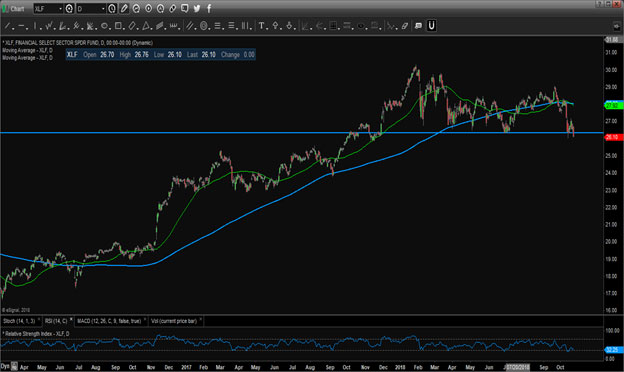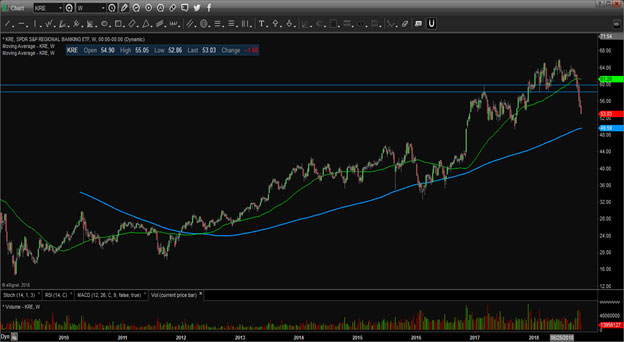Financial Flameout: As Go Financials, So Goes the Market?
 |
As go financials, so goes the market?
That’s what I’m pondering this week, and what you should be thinking about, too.
After all, banks, brokers and other related firms are among the most credit- and economically sensitive stocks in the market. They topped out well ahead of the averages at the end of the LAST bull market. And their dismal performance over the past several months raises serious questions about the health of THIS one.
Start with this chart of the Financial Select Sector SPDR Fund (XLF, Rated “B-”), one of the most diversified sector ETFs. It owns megabanks like JPMorgan Chase (JPM, Rated “B”), investment banks like Goldman Sachs (GS, Rated “C”), credit card companies like American Express (AXP, Rated “B-”), and insurers like MetLife (Met, Rated “C”).
 |
You can see that it topped out with the broad averages back in January, then made a LOWER high in September even as they made higher highs.
That’s a key divergence, similar to other divergences I noted two weeks ago in the credit and volatility markets. The Financial SPDR broke below both its 50-day and 200-day moving averages next, then sank to an 11-month low!
Within the financial sector, banks look particularly sick — especially relatively smaller ones. Take a look at this chart of the SPDR S&P Regional Banking ETF (KRE, Rated “B-”), which includes shares of regional and super-regional institutions like KeyCorp (KEY, Rated “B”), SunTrust Banks (STI, Rated “B”), Comerica (CMA, Rated “B”), and BB&T (BBT, Rated “B”).
There’s not much nice to say about this one …
 |
The Regional Banking SPDR spent several months carving out a top on the chart, then crashed through support in the past couple of weeks. It has now surrendered every penny of gains it had managed to rack up since September 2017.
Why does this matter? Well, if you go back and look at the charts from 2007, you’ll see that the XLF peaked in May. The broader averages tried to hang in there, but they ultimately topped out in October. The S&P 500 wouldn’t recapture its 2007 peak for five-and-a-half years.
It’s too early to say for sure if the same pattern is playing out now. But the signs aren’t exactly encouraging. Indeed, Mark Twain may have been on to something when he reportedly said: “History doesn’t repeat itself, but it often rhymes.”
The good news? You should be side-stepping the flameout in financials. That’s because I told you to get the heck out of these stocks in April, when they were trading much higher.
I went even further in my Weiss Ratings’ Safe Money Report, recommending an investment that RISES in value as financial stocks FALL. It’s performing well for my subscribers given the sector’s struggles, and if you want more details, you can get them by clicking here.
Not ready to join me in Safe Money yet? Then at least heed the advice I’ve shared repeatedly since February:
The character of this market is changing. You have to change with it!
Specifically, cleanse your portfolio of stocks rated SELL by our Weiss Ratings. Carry a much higher level of cash. And invest only in companies with the underlying, fundamental strength to ride out these increasingly troublesome times.
Until next time,
Mike Larson

